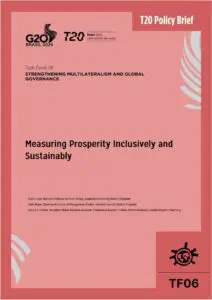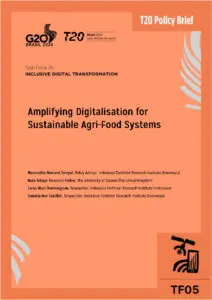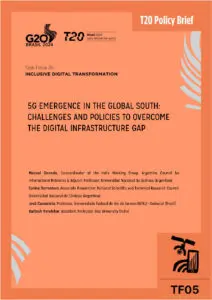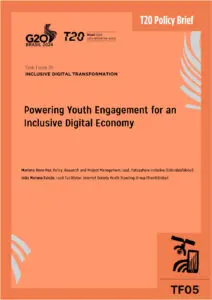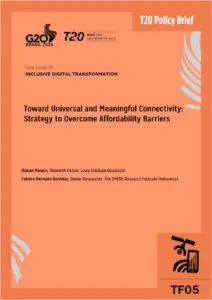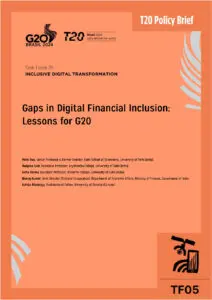This policy brief summarizes the current challenges facing national governments as they undertake decarbonization policies in line with the objectives of the Paris Agreement. The brief emphasizes three policy themes, including the role of urban climate actions, financing transitions toward decarbonization, and comprehensive metropolitan governance mechanisms. We also present nine policy proposals and consider the implementation of recent policies in Paris.
Challenge
The Paris Agreement Preamble recognized the significant role of local governments in tackling climate change. These governments have the power to contribute to meeting the objectives set out in the Paris Agreement by undertaking ambitious policies that ensure decarbonization by 2050 (1).
To avoid exceeding 1.5°C of warming, “global net anthropogenic CO2 emissions decline by about 45% from 2010 levels by 2030 (40–60% interquartile range), reaching net zero around 2050 (2045–2055 interquartile range).” (2) Each year that these targets are missed, the window for limiting the global temperature increase to 1.5°C is reduced by two years. While limiting the global temperature increase to 1.5°C is possible, it requires significant social and technological changes at both the national and subnational levels of governments, as well as support from businesses, NGO´s, academia, and individuals. Otherwise, urban agglomerations around the world will face unprecedented risks by mid-century as they become exposed to temperature increases greater than 1.5°C over preindustrial levels (Revi, Satterthwaite, et al,. 2014).
With 80% of global GDP being generated in urban agglomerations, urban areas account for nearly two-thirds of the world’s energy consumption (UN-Habitat, 2016). In this context, it is estimated that by 2050 two-thirds of the global population will be urban and that 90% of urban growth will be concentrated in developing countries in Asia and Africa (United-Nations; Department of Economic and Social Affairs, 2018). Moreover, megacities (3) are growing both in number and size. Today, 529 million people live in megacities. Globally, the number of megacities is projected to rise from 33 in 2018 to 43 in 2030 (UnitedNations; Department of Economic and Social Affairs, 2018).
These broader economic and demographic trends are reflected in the expansion of urban areas to form urban agglomerations that are highly interconnected. Interdependence within and among these areas requires a new approach to governance that is attuned to targeting global issues such as climate change.
As these urban populations grow, trillions of dollars will need to be spent on expanding and renewing urban infrastructure (OECD, Cities and Climate Change: National governments enabling local action, 2014). Much of this responsibility and expense falls on cities themselves. On average, subnational governments in selected OECD countries are responsible for 64% of climate-related spending and investment (OECD, UN Environment, & World Bank Group, Financing Climate Futures: Rethinking Infrastructure, 2018) (4). However, cities are often limited in their ability to raise the funds needed to finance infrastructure and ensure that cities are low in emissions and resilient to climate change.
As cities move toward a decarbonized future, they are working together to better understand the implications of emissions climate change; articulate what constitutes appropriate limits to residual emissions and offsetting; establish effective and transparent reporting requirements; and develop a more robust understanding of the barriers and challenges to achieving a decarbonized future. In the context of these challenges, cities are working to establish a shared policy framework of municipal and regional carbon neutrality aligned with existing accounting protocols and the emergent international consensus on what constitutes a truly decarbonized future. As part of this process, cities are identifying common principles to address residual emissions as well as how emissions should be measured and reported. These guidelines are consistent with existing environmental integrity standards and global mechanisms, such as the internationally-transferred mitigation outcomes (ITMOs) of Article 6 of the Paris Agreement.
While they may share common features, cities are unique in how these features combine to create governing structures and challenges, making for different approaches to decarbonization efforts and targeting residual emissions. Moreover, depending on local interests within each city and the city’s relationship with the national government, different approaches are taken to climate action, negative emissions technologies, projects that offset carbon, and the purchase of carbon credits.
City-scale approaches to the management of decarbonization transition and any residual emissions are built on internationally-accepted environmental integrity principles. These principles stress that reductions (or removals) must be real, permanent, measurable, independently audited, unambiguously owned, and transparent.
Proposal
1. National governments of G20 countries should work with city governments to target decarbonization objectives while empowering the country as a whole to achieve Nationally Determined Contributions.
Existing greenhouse gas (GHG) accounting and target-setting protocols refer to terms such as “carbon neutrality” and “net zero,” though to date they (5) have not been clearly and consistently defined, which limits cities’ ability to effectively plan long-range emissions reductions, avoid carbon lock-in (6) and harmonize with national carbon management efforts. There is broad agreement amongst cities that decarbonization should be achieved at the citywide scale (7), yet it is currently unclear how to manage residual emissions – the emissions that remain when all feasible emissions reductions efforts within a city have been fully implemented. As such, there is a need for countries and cities to work together to develop decision support processes, mechanisms and tools that support cities to meet their own local objectives while empowering countries to achieve their Nationally Determined Contributions.
Offsetting and carbon removal mechanisms should only be employed by cities once all other technically and economically feasible opportunities to reduce emissions, across all scopes and sectors, have been fully implemented. This ensures that cities and nations have the most shared opportunity to cut emissions.
Depending on the jurisdictional powers and constraints within which they operate, cities may wait until closer to the target year of their emissions reduction efforts before offsetting their emissions, or they may start to offset their emissions ahead of their target year – the choice of which will be driven by local and temporal considerations. Similarly, cities may consider using negative emissions technologies or carbon dioxide removal approaches early on, or decide to wait to deploy these measures closer to the target year. In both cases, the chosen approach changes the dynamic of the city’s carbon management approach and the city’s relationship with national emission reduction efforts. There are a series of potential benefits, disadvantages and risks associated with optimizing the timing of residual emissions management which cities and nations must consider in their shared responsibility to a decarbonized future.
2. Recognize the urgency of prioritizing decarbonization efforts and the benefits linked to this.
Cities’ decarbonization efforts are most often local actions that bring city, regional, national and international benefit. Local decarbonization projects, within the home region or country (but outside the city’s inventory boundary) can deliver local/regional job and economic improvement as well as other benefits such as improved resiliency, air quality, and health outcomes; while sustainable development projects focused on carbon reduction help build the required solidarity for transformative national and global climate action. In general, and independent of location, decarbonization projects provide not only emissions mitigation but numerous other ancillary benefits, such as improved equity, increased climate resilience, improved biodiversity and better human health outcomes.
Gross vs Net Emissions
To ensure transparency, and enable meaningful and accurate reporting of progress towards their carbon neutrality goals, cities should report net emissions separately from gross emissions (8). The reporting of net emissions is what allows cities to track progress against their carbon neutrality goal.
3. Empower local governments to finance the low-emission, resilient transition by aligning national and local fiscal regulations with investment needs in cities
One of the primary challenges for cities in accessing sufficient financing is their limited ability to tax or borrow, which can be constrained by legislation at higher levels of government. While these constraints may help to limit financial risks, it can also deprive cities of important sources of finance.
Supportive national policy frameworks and legislation are necessary to ensure that cities have the resources, incentives and potential to implement effective climate initiatives. National policies and legislation typically determine the framework conditions within which cities operate, including their revenueraising ability.
Financing mechanisms for climate-resilient urban infrastructure include the use of catastrophe bonds, the establishment of dedicated finance facilities, dedicated global climate funds, as well as official development assistance for cities in developing countries (see Table 1). Financial instruments such as green bonds can provide an opportunity to raise funds for green infrastructure projects. Subnational green bond growth issuance is rising, and accounted for 21% of green bond issuance in 2017 (Climate Bonds Initiative, 2017).
A strong national framework using market-based instruments (for example, carbon pricing schemes and performance standards) can broaden the range of environmentally and economically effective options available to cities. National governments can also build environmental goals into national and urban planning strategies, and encourage climate action through grants and subsidies. It is equally important to identify national policies that conflict with or prevent local climate action.
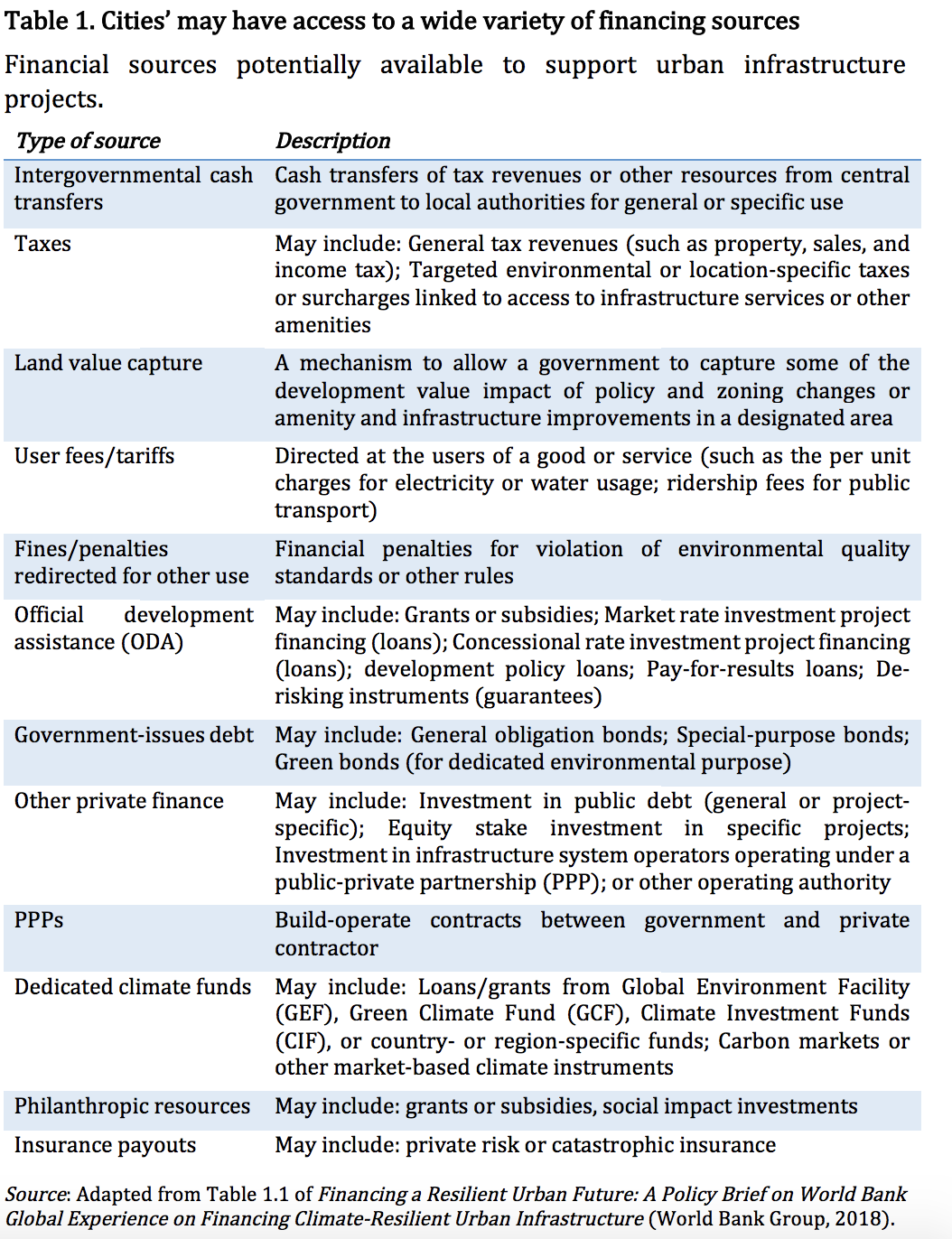
Tellingly, the Inter-American Development Bank (IDB) governance database shows that fewer than half of all countries have devolved fiscal or legislative powers to subnational governments (Floater, et al., 2017). Those cities with devolved revenue-raising capacity – such as Tokyo and Paris – can align their existing municipal revenue streams to help achieve climate goals (Slack, 2016). For example, congestion charges and parking fees can help prompt users to use lower-emitting public transit alternatives, and property taxes and development charges can encourage density in urban areas (OECD, 2013; OECD, 2018). Some cities can also introduce emissions pricing initiatives, offering the dual benefit of raising revenues that fund low-emission, resilient infrastructure while also helping to internalise the costs of emissions. For example, Beijing, Shenzhen and Tokyo have all implemented or are planning to implement emissionstrading schemes (World Bank & Ecofys, State and Trends of Carbon Pricing 2018, 2018).
To help cities achieve their targets, multi-national development banks and development finance institutions can provide technical support to facilitate access to international markets. Further, they can propose city-specific financial instruments such as bonds and grants to scale up investment. Additional guarantee mechanisms can help improve cities’ credit-worthiness. Some private- and public-sector coalitions, such as the Cities Climate Finance Leadership Alliance, are already working to mobilise and accelerate investment in low-emission and resilient infrastructure in cities and urban areas.
Finally, national finance ministries can help by reviewing the fiscal framework of cities and identifying misalignments with climate objectives, and by developing national legislation that clearly articulates whether cities can borrow and under what circumstances. Cities and local governments can align local taxes and charges with low-emission, resilient development (such as introducing appropriately priced parking fees, congestion charges and emissions pricing), and reform fees and taxes that encourage sprawl.
4. Build climate and project finance capacity in cities
Only 20% of the world’s 150 largest cities have basic analytical tools at their disposal for low-carbon urban planning – for example, quantifying the greenhouse gas emissions associated with economic activity and consumption in a city (World Bank, Planning and Financing Low-Carbon, Livable Cities, 2013). Developing capacity in local governments and administrations is fundamental to making climate action work, particularly in developing countries that suffer from capacity constraints and severe vulnerabilities to the adverse effects of climate change.
Sufficient capacity can help overcome some of the challenges to infrastructure investment. Increased capacity can bring a better understanding of administrative procedures, procurement procedures, co-ordination with other levels of government and jurisdictions, and strategic planning. National governments can fund programmes that provide training and technical support to enhance access to private capital markets. Building institutional capacity and expertise can help cities prepare for and package infrastructure projects into attractive bankable projects for private investors. Cities could also strengthen their long-term planning capacity, including their use of tools such as costbenefit analysis to ensure a strong information base is being used for decision making.
National governments and development finance institutions can help by building local capacity to access private capital markets and to work with the private sector (OECD, Cities and Climate Change: National governments enabling local action, 2014). They can strengthen capacities and skills in developing risk-informed urban plans, and in designing and selecting urban infrastructure that takes into account a range of future climate conditions and the associated uncertainties. They can also help build climate-related capacities to develop long-term low-emission strategies and measure greenhouse gas emissions and progress.
Assisting cities through strengthened financial performance and enhancing city leaders’ knowledge of revenue management, expenditure control, debt management, asset maintenance, and capital investment planning is central to unlocking and improving creditworthiness (World Bank, City Creditworthiness Initiative: A Partnership to Deliver Municipal Finance, 2018). Further affecting creditworthiness is cities’ inability to collect revenue, which limits their capacity to borrow. Relatedly, the lack of transparent accounting practices is another important barrier, particularly in developing countries.
Estimates suggest that less than 4% of the largest 500 cities in developing countries are considered creditworthy in international markets, and less than 20% are considered creditworthy in local markets (World Bank, Financing Sustainable Cities: How We’re Helping Africa’s Cities Raise Their Credit Ratings, 2013). Improving creditworthiness can have tremendous impacts: just USD 1 of investment in improving city creditworthiness in a developing country can leverage more than USD 100 in private investment in sustainable urban infrastructure (World Bank, Financing Sustainable Cities: How We’re Helping Africa’s Cities Raise Their Credit Ratings, 2013). City creditworthiness initiatives and project preparation facilities, such as the World Bank’s City Resilience Program (CRP) and the C40 Finance Facility, can support public entities’ capacities in developing bankable projects and scale up their investment in infrastructure. This applies in particular to cities in developing countries, as the majority still lack access to external financing sources.
5. Seize the development benefits of low-emission, resilient planning
Core climate policies – such as those relating to energy, transport and carbon taxation; subsidy and pricing reforms; support for renewable and low-carbon energy; energy efficiency programmes; and transport planning and management – have the potential to affect household spending and the affordability of energy, transport services and housing. Policies outside the climate portfolio can also influence climate and inclusive growth. For instance, local tax policies, by affecting the costs and benefits of land use, can have a significant impact on emissions and housing affordability. Considering the impacts of policies at the subnational level on development and inclusiveness is therefore central to strategic, cohesive planning.
Climate policies and strategies present both threats and opportunities for more inclusive growth. If appropriately planned, low-emission, resilient infrastructure can have positive impacts on vulnerable populations. For instance, increased investment in urban transport systems generally improves access to jobs for low-income populations. Subnational and local governments can help by mainstreaming inclusiveness in infrastructure planning. Cities can also integrate climate and inclusiveness outcomes through thoughtful investment of revenues from environmental taxes and fees. They can capitalise skills development and job-creation opportunities in urban infrastructure financing and investment, particularly relating to energy efficiency investments.
Cities have an imperative to be at the forefront of climate action. Aligning national and local fiscal regulations with investment needs and building climate and project finance capacity in cities should be priorities to ensure cities are empowered to lead the transition to a low-emission, resilient future. (9)
6. Strengthen the role nations play in achieving decarbonization objectives by empowering metropolitan coordination for implementing aligned climate strategies.
Toward the end of the 19th century, many large cities were beset by the health risks of cholera and yellow fever, leading them to invest heavily in water and sanitation infrastructure at a time when urban systems were expanding. To date, the warmest years on record were 2015, 2016, and 2017, and climaterelated effects on development have already been observed in many cities and countries (ECOSOC, 2018). Thus, the climate crisis presents new challenges and opportunities to reconsider the mechanisms of local and national governance and decision making. The lesson to be drawn is that sustainable development increasingly depends on “the successful management of urban growth.” (United-Nations; Department of Economic and Social Affairs, 2018). In a world where cities are continuously expanding, urban planning should promote compact, organized, efficient, and socially cohesive, metabolically efficient cities (Lanfranchi, Herrero, Rueda, Bauer, & Camilloni, 2018).
Cities expand conforming urban agglomerations, which according to UN (10), represent a “population contained within the contours of a contiguous territory inhabited at urban density levels without regard to administrative boundaries”. Urban agglomerations are social, economic and environmental linked, creating a high interdependence among different administrative units, turning therefore into metropolitan urban systems. Metropolitan areas involve participation of other levels of government that affect the decision-making structure of the system.
Thus, not surprisingly, climate change and urbanization are also increasingly linked by urban services and functional systems. Not only do infrastructure, energy, water, waste, and transportation systems have a direct effect on urbanGHG emissions (Colenbrander, Lindfield, Lufkin, & Quijano, 2018), cities themselves also tend to suffer hard from the consequences of climate change because shifting weather patterns put these systems at risk. Climate actions in a large city are interventions to the urban functional system that encompass the entire scope of the agglomeration – rather than being limited to fragmented patches of territory – in order to be effective. Such holistic interventions are key for policy initiatives that improve governance across entire territories. Notwithstanding, there are currently few cases where such models of metropolitan governance exist. Most existing urban government models have their roots in the formation of nations in the eighteenth and nineteenth centuries. During this period, administrative and spatial boundaries matched the local governing power of cities. During the twentieth century, with the advent of the automobile and highways, cities expanded beyond their original limits. Yet despite such expansion, mechanisms for local government remained mostly unchanged. As cities and their urban systems continue to grow and expand – demanding and consuming more energy-traditional governing arrangements and mechanisms of urban areas are being challenged (McCarney, Blanco, Carmin, & Colley, 2011). At present, the existing level of interdependence in metropolitan areas requires a new approach for governance that is attuned to targeting climate change. In addition to that, horizontal coordination is needed for managing multiple institutions that co-exist in a metropolis, particularly when common challenges pose a threat to all actors involved.
On the other hand, local strategies have to be aligned with national policies and goals, taking into account how local authorities serve as a vehicle for the implementation of nationally driven policies (Corfee-Morlot, et al., 2009). Even more, cities will have to work with nation states in order to cancel out emissions from fuel use in buildings, transport, industry, the provision of gridsupplied energy and through the treatment/disposal of waste generated within the city, since such opportunity of cancelling out exist almost exclusively outside city boundaries, mostly because local governments do not have the power or capacity to drive it. In this vein, the new metropolitan entity should be the one, which carries out low carbon strategies designed by multiple political-administrative levels of an urban agglomeration, including the identification of financial, social and political barriers for implementing metropolitan climate strategies (Lanfranchi & Contin, 2017).Also, pressure to reduce carbon emissions in certain sectors could hurt competitiveness of some sectors vis-à-vis other sectors of the city and drive companies to relocate to districts where policies are less stringent. The role of nations is central to generating incentives for subnational governments to define instances and mechanisms of public-private metropolitan coordination.
Improving metropolitan governance and tackling contemporary urban challenges requires a new approach to territorial management. Such an approach includes the reforming of longstanding legal frameworks, the creation of institutions capable of managing metropolitan systems, the development of financing tools essential to funding, the building of new green infrastructure, and the design and implementation of participatory methods for metropolitan planning and action. As an example, in order to promote consensus and dialogue between stakeholders, CIPPEC Cities Program has developed a method called PlanificACCION (Planning & Action). This method allows simultaneously targets planning and action by combining the use of participatory planning strategies and project co-creation. It also allows for the rapid identification of key challenges and goals followed by strategic projects that promote dialogue and consensus building while providing quick solutions for governments and their citizens. By facilitating participatory planning and building social capital among leaders and communities, PlanificACCION contributes to reframe the way we plan and act towards the comprehensive development of cities. It focuses on developing policies in key areas for development: reducing inequalities, enhancing urban resilience, promoting inclusive digitalization and empowering metropolitan governance (Lanfranchi & Yañez, 2018).
The G20 should recognize the benefits of a new integrative metropolitan approach for addressing those barriers and at the same time dealing with the challenges arisen by the complex interrelations of human, environmental, work, commerce, education, and health systems of a metropolis.
7. Create under G20 a metropolitan working group, which focuses on promoting the development of comprehensive territorial policies between the nation and subnational governments.
As said previously, new metropolitan governance that extends beyond formal jurisdictions should be developed for managing and leading climate actions in a coherent fashion. In addition, metropolitan entities could strengthen their financing capacity through backing/guarantees from national governments.
In addition to the challenges facing local governments due to their weak fiscal autonomy, they also often lack capacity in areas such as measuring emissions, mainstreaming climate risks in infrastructure planning, and financing and delivering infrastructure projects efficiently. Monitoring and verification powers could be transferred to metropolitan entities that should be tailored for each metropolitan area. Decarbonizing a metropolitan region will undoubtedly require joint efforts and both horizontal and vertical coordination, since it relies on complex inter-governmental policy networks and organizational management (McCarney, Blanco, Carmin, & Colley, 2011). It is essential to review the governmental schemes and foster a comprehensive institutional approach to be addressed across the metropolis instead of territorial jurisdictions or thematic sectors (Gómez-Álvarez, and Lanfranchi, 2017). The state, as we understand it today, is not the only social actor capable of giving shape to a local reality. Companies, social organizations and individuals connected through social networks play a critical role in the transformation of this reality. Thus, to be effective, Climate Action Plans should grow out of consensus and active participation of an array of political, economic, and social actors whose interests are tied to the territory in question. They should be involved in the early stages of climate strategy planning, by defining sectors priorities, barriers and opportunities. Also, the engagement of the community ensures the effective implementation of climate change policies, while generating legitimacy in its implementation (Gómez Álvarez and Lanfranchi, 2017).
G20 should take note of the strategic role metropolitan governance could play in implementing climate strategies at regional level and thereby they should be recognized for their contribution in the G20 framework. To thrive in meeting today’s global challenges, empowerment of cities is paramount, by raising the profile of urban issues in the G20 agenda and ultimately enhancing the role of cities in the G20 process (Lanfranchi &Yañez, 2018).
Finally, in 2018, during the G20 Argentina, the Climate Action & Infrastructure for Development Task Force proposed to formalize the Urban 20 as engagement group within the G20 system, as a space to enrich discussions regarding urban issues. The U20 Summit, empowered by C40, showed the high relevance that subnational governments have for tackling global threats such as climate change. During G20 Japan, the formalization took place, being U20 officially an engagement group. This is an important step in recognizing the role of cities in the global arena.
Lessons for the Implementation of Decarbonization Policies
We now turn our attention to implementation and consider policies undertaken in Paris, to highlight how cities are tacking the challenges of climate change through an array of actions that span across these three policy perspectives.
Paris’ ambitious climate plan sets out a policy trajectory over the next 30 years and includes 500 actions for implementation. These actions cover a broad spectrum of issues, ranging from the production of urban space to social inclusion. Paris is emblematic not only of the advancements that cities can make in tackling the challenges of climate change through the sort of policy instruments discussed in this brief, it also invites us to consider the persistent challenges that cities face, such advancements notwithstanding. In this context, the case offers lessons to policymakers for targeting climate change through the decarbonization of cities.
Overview of Policy advancements in Paris
8. Acknowledge the role of local governments as pathfinders to support the transition and rapid actions
Today, decarbonization depends on reducing energy consumption and greenhouse gas emissions and investing in alternative and renewable forms of energy. These objectives call attention to how the city is constructed and managed and, more broadly, how the practices and lifestyles of those who benefit from the city shape it.
While the Grand Paris metropolitan authority area is home to 7 million people, the 105 km2 area of the city itself comprises 2.2 million residents, 1 million commuters, 280,000 tourists every day (34 millions in 2017), bringing the daily density to more than 30,000 people per km2. One of the significant climate change challenges for Paris has its roots in its dense and compact urban form: it is about strengthening the assets it can offer (the city of short distances, of social and functional mix) while limiting negative impacts such as the effects of urban heat islands or the consequences of urban sprawl experienced during the 20th century.
Beginning in 2001, policies targeting collective urban mobility and the recuperation of public spaces were launched and mark the first series of projects toward low-carbon transition. These included the creation of a bicycle network, a large-scale bicycle share system of more than 20,000 bicycles, investments in bus lanes, in tramway infrastructure to reconnect public spaces, and the extension of metro lines. By 2004, the city had begun to assessing its impact in terms of greenhouse gas emissions.
In 2007, the first climate plan was unanimously approved. It set the first objectives for reducing greenhouse gas emissions and energy by 25% and investing in renewable energy for public buildings, such as government, schools, and social housing, among others. In 2012, a second climate plan was begun; it marked an important step toward heightened public awareness. Between 2004 and 2014, the carbon footprint of the Paris region was reduced by nearly 10%.
Paris is part of the precursor group of the “1.5°C” cities of C40 and proposes an ambitious and pioneering objective of the carbon neutrality of cities. In March 2018, the new Parisian Climate Plan was unanimously approved by the Paris Council. The final approval of this plan was the culmination of a five-month policy process that brought together citizens, professionals, associations, and experts. This process made way for a shared vision for meeting the challenges of carbon neutrality. In November 2018, following the approval of the Paris Climate plan, the Greater Paris Metropolis, which includes the City of Paris and 130 other municipalities, approved its Metropolitan Air Climate and Energy Plan. Similarly, the plan targets climate neutrality and its approval is emblematic of democratic decision making and consensus, with 131 municipalities unanimously voting in favour of the plan. Also, Paris decided to set up a low emission zone on its territory, joined by the Metropolis, which now wishes to extend it to 78 other municipalities.
In addition to that, this city decided to ban diesel engines by 2024 and all thermal engines by 2030 facing another major issue, air quality. The objectives of these advancements are to promote alternative forms of energy, such as electric hubs, NGV/BioNGV stations, and hydrogen stations.
Finally, additional policy initiatives focus on reducing waste production at the source, improving systematic sorting and reuse of waste, and promoting the circular economy and sustainable food chains.
Ongoing challenges
9. Enable local governments to adapt or develop the necessary legal and regulatory tools
Notwithstanding recent policies that promote decarbonization and mitigate the underlying causes of climate change, Paris faces ongoing policy challenges. For one, thermal renovation of the built environment will present a major challenge over the next thirty years: 85% of Paris’ energy consumption is due to residential and tertiary buildings (110,000 buildings concerned). Massive building renovation thus requires not only mobilizing all existing regulatory, incentive, operational and financial levers, but also reinforcing obligations at the level of the law.
The progressive and comprehensive greening of energy networks is also a major challenge. In France, energy networks are owned by local authorities. Paris can therefore set binding targets for the share of renewables in the energy mix and include them in contracts with its network operators to achieve 100% green energy by 2050. This greening is linked to energy production wherever it is relevant by mobilising all the local energy sources available (geothermal, solar, energy recovery, wind energy). To achieve this, obstacles still need to be removed, such as regulations related to landscape planning and historical preservation, which prevent the installation of solar panels on roofs. Local forms of energy production and distribution such as self-consumption must also make it possible to limit the demand and investments on the networks, which continue to play a major role. With this local/global hybridization, the carbon impact remains contained while contributing to making these networks more robust and resilient.
Aiming for carbon neutrality also means exploring all avenues to avoid/limit greenhouse gas emissions, including:
- optimizing existing buildings (rather rehabilitating than destroying them, deconstructing than demolishing them) and the developing programme flexibility (to be able to transform offices into housing, nurseries into facilities for people with disabilities);
- optimizing the uses and role of buildings, as a resource for their environment (by hosting greening, urban services, urban agriculture, etc) or by considering underutilized areas (vacant premises, car parks, schoolyards, etc.) as a permanent or temporary source;
- using bio-sourced, low-carbon materials should also lead to a reconsideration of the energy performance criterion, which appears increasingly insufficient, in view of the need to reduce the carbon footprint in construction.
- de-waterproofing, greening: a city’s carbon neutrality requires the climatic adaptation of its open spaces and buildings in order to avoid the use of air conditioning and to limit the effects of urban heat islands. Breaking the carbon intensity of public space can be achieved through the use of sustainable, low-carbon materials and/or with interesting climate benefits. Permeable soils also prevent overloading of the sewerage system and promote urban cooling.
- mutualizing at all scales, from the building to the neighbourhood, taking advantage of the specificity of mixed and dense urban fabrics and going beyond the boundaries (property, parcel) and the inherent legal and technical obstacles, by taking advantage of the temporality of energy (heat exchanges between tertiary and residential buildings), by reinforcing solidarity between new buildings and stock (the “resource” building for its environment), by taking advantage of the mass effect (areas where several buildings can be grouped together for rehabilitation purposes), or even at the micro level by facilitating encroachment on the private space of the neighbouring plot to provide external thermal insulation.
Most of these tracks will also require an adapted regulatory framework.
Lessons to be drawn
Overall, several qualities underlie the policy advances in the Paris case, which should be taken into account in order to replicate the lessons to be drawn:
1. A strong and shared political will for overcoming resistance to changes in the status quo
2. A set of planning instruments to guide the development of policies and their implementation: climate plans, adaptation strategies, resilience strategies, urban regulations, incentive programs to promote innovation
3. Multiscale projects that incorporate the local, metropolitan, regional, national levels of governance
4. Coordination across sectors, including business, civil society, and government to build consensus on policy initiatives
Conclusion
This policy brief has stressed the importance of policy advancements in three key crosscutting policy areas: the proactive role of urban climate actions in advancing the objectives of the Paris Agreement, pathways for financing the transition, and the need for new metropolitan governance mechanisms that take into account for the urban system as a whole. The nine we’ve included show how cities can tackle the challenges of climate change in line with the Paris Agreement. These proposals can be summarized as follows:
1. National governments of G20 countries should work with city governments to target decarbonization objectives
2. Recognize the urgency of prioritizing decarbonization efforts
3. Empower local governments to finance the low-emission and resilient transition
4. Build climate and project finance capacity in cities
5. Take advantage of the development benefits of low-emission, resilient planning
6. Strengthen the role nations play in achieving decarbonization objectives
7. Create under G20 a metropolitan working group
8. Acknowledge the role of local governments as pathfinders to support the transition
9. Enable local governments to adapt or develop the necessary legal and regulatory tools
NOTES
1 https://www.c40.org/other/deadline_2020
2 IPCC Special Report on the Impacts of Global Warming, 2019.
3 Cities with more than 10 million inhabitants are often termed “megacities” (WUP, 2016)
4 Climate investments can be defined as the acquisition (including purchases of new or second-hand assets) of assets for climate purposes (e.g. installing coastal defences against flooding and sea level rise). Climate spending can be defined as the amount of money spent on operating and maintain these (e.g. strengthening coastal defences).
5 Annex B: Carbon Protocols and Standards reviewed for this document <>
6 C40 carbon lock-in report: Keeping cities green: Avoiding carbon lock-in due to urban development, https://www.sei.org/publications/keeping-cities-green-avoiding-carbonlock-in-due-to-urban-development/
7 Not just at the municipal operations level but including all those who are responsible for emissions in the city such as the private sector, citizens and government institutions
8 Gross emissions include all relevant emissions in all covered emissions scopes, excluding any GHG emissions reductions from carbon credits retired or sold. Net emissions is equal to the gross level of emissions less all applicable GHG emissions reductions claimed from carbon credits purchased, and adding GHG emissions from carbon credits sold.
9 Note that recommendations 3, 4, and 5 are adapted from OECD/The World Bank/UN Environment (2018), Financing Climate Futures: Rethinking Infrastructure, OECD Publishing,Paris, https://doi.org/10.1787/9789264308114 en.
10 [1] United Nations, Department of Economic and Social Affairs, Population Division (2018). The World’s Cities in 2018—Data Booklet (ST/ESA/ SER.A/417); https://population.un.org/wup/General/FAQs.aspx.
REFERENCES
• McCarney, P., Blanco, H., Carmin, J., & Colley, M. (2011). Cities and climate change. Climate Change and Cities: First Assessment Report of the Urban Climate Change Research Network.
• United-Nations; Department of Economic and Social Affairs. (2018). The World’s Cities in 2018—Data Booklet.
• Colenbrander, S., Lindfield, M., Lufkin, J., & Quijano, N. (2018). Financing LowCarbon, Climate-Resilient Cities. London & Washington.
• Corfee-Morlot, J., Kamal-Chaoui, L., Donovan, M., Cochran, I., Robert, A., & & Teasdale, P. (2009). Cities, Climate Change and Multilevel Governance.
• Lanfranchi, G., Herrero, A., Rueda, S., Bauer, S., & Camilloni, I. (2018). The New Urban Paradigm. T20 Argentina.
• Ahrend, R., JK., S., & C.A, L. (2017). Why Metropolitan Governance Matters and How to Achieve It. En Steering the Metropolis.
• Lanfranchi, G., Herrero, A., Fernandez, J., Rojas, F., & Trostmann, K. (2018). Enhancing Climate Resilience through Urban Infrastructure and Metropolitan Governance.
• UN-Habitat. (2016). World Cities Report 2016; Urbanization and Development,. Nairobi, Kenya: UN-Habitat.
• Rosenzweig, C., & S, L. W. (2015). ARC3.2 Summary for City Leaders. New York: Urban Climate Change Research Network. Columbia University.
• Revi, A., Satterthwaite, D., Aragón-Durand, F., Corfee-Morlot, J., Kiunsi, R., M., P., . . . Solecki, W. (2014). Chapter 8 Urban Areas. En IPCC, IPCC, Climate Change 2014: Mitigation of Climate Change. Contribution of Working Group III to the Fifth Assessment Report of the Intergovernmental Panel on Climate Change (págs. 535- 612). Cambridge; New York, UK;USA: Cambridge University Press.
• Lanfranchi, G., & Yáñez, F. (2018). Urban challenges in the 21st Century Social capital and innovation as key factors for implementing integrated development approaches . White Paper – Urban20.
• Gómez Álvarez, D., & Lanfranchi, G. (2017). Metropolitanism: Final Remarks on Steering the Metropolis. En D. Gómez Álvarez, & G. LAnfranchi, Steering the Metropolis: Metropolitan Governance for Sustainable Urban Development. Washington, EEUU: IDB.
• Lanfranchi, G., & Contin, A. (2017). The Rise of a New Discipline to Manage Metropolitan Urban Systems. En D. Gómez Álvarez, R. Rajack, E. López Moreno, & G. Lanfranchi, teering the metropolis: metropolitan governance for sustainable urban development. Washington: IDB
• UNDESA. (2018). World Urbanization Prospects: The 2018 Revision. United Nations Department of Economic and Social Affairs, New York City. Retrieved 10 22, 2018, from https://esa.un.org/unpd/wup/Publications/Files/WUP2018-KeyFacts.pdf
• OECD. (2014). Cities and Climate Change: National governments enabling local action. OECD Publishing, Paris. Retrieved 10 22, 2018, from https://www.oecd.org/env/cc/Cities-and-climate-change-2014-PolicyPerspectives-Final-web.pdf
• OECD, UN Environment, & World Bank Group. (2018). Financing Climate Futures: Rethinking Infrastructure. OECD Publishing, Paris. Retrieved from https://dx.doi.org/9789264308114-en
• Climate Bonds Initiative. (2017). Bonds and Climate Change: The State of the Market 2017. Climate Bonds Initiative. Retrieved 09 27, 2018, from https://www.climatebonds.net/files/reports/cbi-sotm_2017- bondsclimatechange.pdf
• Floater, G., Dowling, D., Chan, D., Ulterino, M., Braunstein, J., Mcminn, T., & Ahmad, E. (2017). Global Review of Finance for Sustainable Urban Infrastructure. Coalition for Urban Transitions. Retrieved 07 24, 2018, from https://newclimateeconomy.net/content/cities-working-papers.
• Slack, E. (2016). International Comparison of Global City Financing. University of Toronto, Munk School of Global Affairs, Institute on Municipal Finance and Governance. Retrieved 10 26, 2018, from https://www.london.gov.uk/sites/default/files/03_international_comparison_of_gl obal_city_financing_october_2016.pdf
• OECD. (2013). Green Growth in Cities. In OECD Green Growth Studies. OECD Publishing, Paris. doi:https://dx.doi.org/10.1787/9789264195325-en
• OECD. (2018). Rethinking Urban Sprawl: Moving Towards Sustainable Cities. OECD Publishing, Paris. doi:https://dx.doi.org/10.1787/9789264189881-en
• OECD/The World Bank/UN Environment (2018), Financing Climate Futures: Rethinking Infrastructure, OECD Publishing, Paris, https://doi.org/10.1787/9789264308114-en.
• World Bank, & Ecofys. (2018). State and Trends of Carbon Pricing 2018. World Bank, Washington, DC. Retrieved from https://openknowledge.worldbank.org/handle/10986/29687
• World Bank. (2013). Planning and Financing Low-Carbon, Livable Cities. World Bank Web Portal. Retrieved 10 22, 2018, from https://www.worldbank.org/en/news/feature/2013/09/25/planning-financinglow-carbon-cities
• World Bank. (2018). City Creditworthiness Initiative: A Partnership to Deliver Municipal Finance. World Bank Web Portal. Retrieved 10 22, 2018, from https://www.worldbank.org/en/topic/urbandevelopment/brief/citycreditworthiness-initiative
• World Bank Group (2018), “Financing Resilient Urban Infrastructure: Lessons from World Bank and Global Experience”, Financing Climate Futures Case Studies, World Bank Group, Washington, DC, https://documents.worldbank.org/curated/en/370831544454490426/pdf/132822 -WP-PUBLIC-8-12-2018-3-26-37-FRUFFinalDec.pdf.
• World Bank. (2013). Financing Sustainable Cities: How We’re Helping Africa’s Cities Raise Their Credit Ratings. World Bank Web Portal. Retrieved 10 22, 2018, from https://www.worldbank.org/en/news/feature/2013/10/24/financing-sustainablecities-africa-creditworthy
• Bast, Eliszabeth, Alex Doukas, Sam Prickard, Laurie van der Burg and Shelagh Whitley (2015). Empty promises. G20 subsidies to oil, gas and coal production. Report by the Overseas Development Institute (ODI) and Oil Change International (OCI), November 2015.



